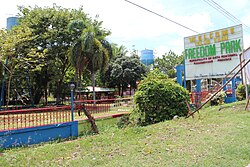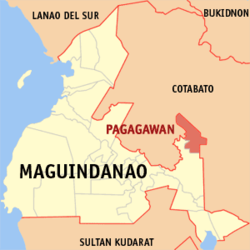Datu Montawal
Datu Montawal
Pagagawan | |
|---|---|
| Municipality of Datu Montawal | |
 Freedom Park | |
 Seal | |
 Map of Maguindanao with Datu Montawal highlighted | |
 Datu Montawal Location within the Philippines | |
| Coordinates: 7°06′N 124°46′E / 7.1°N 124.77°ECoordinates: 7°06′N 124°46′E / 7.1°N 124.77°E | |
| Country | Philippines |
| Region | Bangsamoro Autonomous Region in Muslim Mindanao |
| Province | Maguindanao |
| District | 2nd district |
| Founded | July 18, 2000 |
| Barangays | 11 (see Barangays) |
| Government | |
| • Type | Sangguniang Bayan |
| • Mayor | Ohto C. Montawal |
| • Vice Mayor | Vicman K. Montawal |
| • Representative | Esmael G. Mangudadatu |
| • Municipal Council | Members |
| • Electorate | 17,457 voters (2019) |
| Area | |
| • Total | 461.10 km2 (178.03 sq mi) |
| Elevation | 14 m (46 ft) |
| Highest elevation | 36 m (118 ft) |
| Lowest elevation | 8 m (26 ft) |
| Population (2020 census) | |
| • Total | 37,314 |
| • Density | 81/km2 (210/sq mi) |
| • Households | 5,608 |
| Economy | |
| • Income class | 5th municipal income class |
| • Poverty incidence | 59.40% (2015)[3] |
| • Revenue | ₱119,000.00 (2020) |
| • Assets | ₱1,372,000.00 (2020) |
| • Expenditure | ₱103,412.00 (2020) |
| • Liabilities | ₱65,000.00 (2020) |
| Service provider | |
| • Electricity | Maguindanao Electric Cooperative (MAGELCO) |
| Time zone | UTC+8 (PST) |
| ZIP code | 9610 |
| PSGC | |
| IDD : area code | +63 (0)64 |
| Native languages | Maguindanao Ilianen Tagalog |
Datu Montawal, officially the Municipality of Datu Montawal (Maguindanaon: Ingud nu Datu Montawal; Iranun: Inged a Datu Montawal; Tagalog: Bayan ng Datu Montawal), is a 5th class municipality in the province of Maguindanao, Philippines. According to the 2020 census, it has a population of 37,314 people. [4]
The municipality, then known as Pagagawan, was created under Muslim Mindanao Autonomy Act No. 95 on July 18, 2000, carved out of the municipality of Pagalungan.[5] It was renamed to Datu Montawal under Muslim Mindanao Autonomy Act No. 152 on June 9, 2003.[6]
Geography[]
Barangays[]
Datu Montawal is politically subdivided into 11 barangays.
- Balatungkayo (Batungkayo)
- Bulit
- Bulod
- Dungguan
- Limbalud
- Maridagao
- Nabundas
- Pagagawan
- Talapas
- Talitay
- Tunggol
Climate[]
| Climate data for Datu Montawal, Maguindanao | |||||||||||||
|---|---|---|---|---|---|---|---|---|---|---|---|---|---|
| Month | Jan | Feb | Mar | Apr | May | Jun | Jul | Aug | Sep | Oct | Nov | Dec | Year |
| Average high °C (°F) | 32 (90) |
32 (90) |
33 (91) |
33 (91) |
32 (90) |
31 (88) |
30 (86) |
31 (88) |
31 (88) |
31 (88) |
31 (88) |
31 (88) |
32 (89) |
| Average low °C (°F) | 21 (70) |
21 (70) |
21 (70) |
22 (72) |
23 (73) |
23 (73) |
23 (73) |
23 (73) |
23 (73) |
23 (73) |
23 (73) |
22 (72) |
22 (72) |
| Average precipitation mm (inches) | 19 (0.7) |
14 (0.6) |
15 (0.6) |
18 (0.7) |
33 (1.3) |
42 (1.7) |
44 (1.7) |
42 (1.7) |
30 (1.2) |
31 (1.2) |
28 (1.1) |
17 (0.7) |
333 (13.2) |
| Average rainy days | 6.9 | 5.6 | 6.9 | 8.1 | 15.1 | 17.5 | 17.8 | 18.5 | 14.9 | 14.9 | 12.4 | 8.0 | 146.6 |
| Source: Meteoblue (modeled/calculated data, not measured locally) [7] | |||||||||||||
Demographics[]
| Year | Pop. | ±% p.a. |
|---|---|---|
| 1995 | 23,962 | — |
| 2000 | 27,010 | +2.60% |
| 2007 | 32,995 | +2.80% |
| 2010 | 31,265 | −1.94% |
| 2015 | 34,820 | +2.07% |
| 2020 | 37,314 | +1.37% |
| Source: Philippine Statistics Authority [8] [9] [10][11] | ||
Economy[]
| Poverty Incidence of Datu Montawal | |
| Source: Philippine Statistics Authority[12][13][14][15][16][17] | |
References[]
- ^ Municipality of Datu Montawal | (DILG)
- ^ "2015 Census of Population, Report No. 3 – Population, Land Area, and Population Density" (PDF). Philippine Statistics Authority. Quezon City, Philippines. August 2016. ISSN 0117-1453. Archived (PDF) from the original on May 25, 2021. Retrieved July 16, 2021.
- ^ https://psa.gov.ph/sites/default/files/City%20and%20Municipal-level%20Small%20Area%20Poverty%20Estimates_%202009%2C%202012%20and%202015_0.xlsx; publication date: 10 July 2019; publisher: Philippine Statistics Authority.
- ^ Census of Population (2020). "BARMM". Total Population by Province, City, Municipality and Barangay. PSA. Retrieved 8 July 2021.
- ^ "Muslim Mindanao Autonomy Act No. 95; An Act Creating the Municipality of Pagagawan in the Province of Maguindanao, and for Other Purposes" (PDF). Regional Legislative Assembly, Autonomous Region in Muslim Mindanao. Retrieved 27 January 2016.
- ^ "Muslim Mindanao Autonomy Act No. 152; An Act Changing the Name of Pagagawan in the Province of Maguindanao to Municipality of Datu Montawal" (PDF). Regional Legislative Assembly, Autonomous Region in Muslim Mindanao. Retrieved 27 January 2016.
- ^ "Datu Montawal, Maguindanao : Average Temperatures and Rainfall". Meteoblue. Retrieved 19 January 2019.
- ^ Census of Population (2015). "ARMM – Autonomous Region in Muslim Mindanao". Total Population by Province, City, Municipality and Barangay. PSA. Retrieved 20 June 2016.
- ^ Census of Population and Housing (2010). "ARMM – Autonomous Region in Muslim Mindanao". Total Population by Province, City, Municipality and Barangay. NSO. Retrieved 29 June 2016.
- ^ Censuses of Population (1903–2007). "ARMM – Autonomous Region in Muslim Mindanao". Table 1. Population Enumerated in Various Censuses by Province/Highly Urbanized City: 1903 to 2007. NSO.
- ^ "Province of Maguindanao". Municipality Population Data. Local Water Utilities Administration Research Division. Retrieved 17 December 2016.
- ^ "Poverty incidence (PI):". Philippine Statistics Authority. Retrieved 28 December 2020.
- ^ https://psa.gov.ph/sites/default/files/NSCB_LocalPovertyPhilippines_0.pdf; publication date: 29 November 2005; publisher: Philippine Statistics Authority.
- ^ https://psa.gov.ph/sites/default/files/2003%20SAE%20of%20poverty%20%28Full%20Report%29_1.pdf; publication date: 23 March 2009; publisher: Philippine Statistics Authority.
- ^ https://psa.gov.ph/sites/default/files/2006%20and%202009%20City%20and%20Municipal%20Level%20Poverty%20Estimates_0_1.pdf; publication date: 3 August 2012; publisher: Philippine Statistics Authority.
- ^ https://psa.gov.ph/sites/default/files/2012%20Municipal%20and%20City%20Level%20Poverty%20Estima7tes%20Publication%20%281%29.pdf; publication date: 31 May 2016; publisher: Philippine Statistics Authority.
- ^ https://psa.gov.ph/sites/default/files/City%20and%20Municipal-level%20Small%20Area%20Poverty%20Estimates_%202009%2C%202012%20and%202015_0.xlsx; publication date: 10 July 2019; publisher: Philippine Statistics Authority.
External links[]
- Datu Montawal Profile at PhilAtlas.com
- MMA Act No. 95 : An Act Creating the Municipality of Pagagawan in the Province of Maguindanao
- MMA Act No. 152 : An Act Changing the Name of Pagagawan in the Province of Maguindanao to Municipality of Datu Montawal
- Philippine Standard Geographic Code
- Philippine Census Information
- Local Governance Performance Management System
Categories:
- Municipalities of Maguindanao
- Bangsamoro geography stubs

